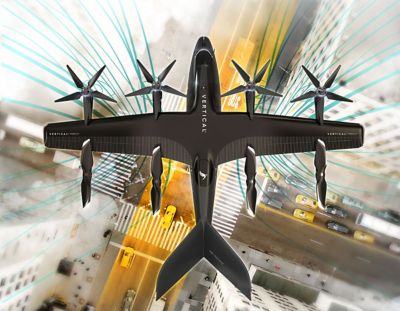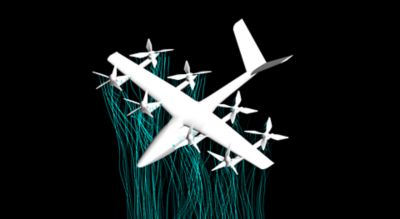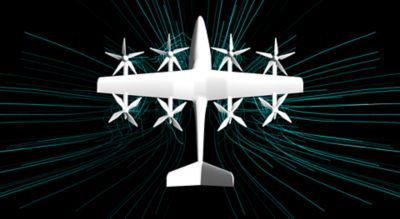-
-
Access Free Student Software
Ansys empowers the next generation of engineers
Students get free access to world-class simulation software.
-
Connect with Ansys Now!
Design your future
Connect with Ansys to explore how simulation can power your next breakthrough.
Countries & Regions
Free Trials
Products & Services
Learn
About
Back
Products & Services
Back
Learn
Ansys empowers the next generation of engineers
Students get free access to world-class simulation software.
Back
About
Design your future
Connect with Ansys to explore how simulation can power your next breakthrough.
Free Trials
ANSYS BLOG
June 9, 2023
Going Up: Simulation Advances eVTOL Development
You can’t tell just by looking skyward, at least not yet, but there’s a race to control the urban airways, and Ansys computational fluid dynamics (CFD) software is helping one contender gain a lead.
The goal is to get a new class of aircraft — highly automated, exceptionally complex electric vertical takeoff and landing (eVTOL) vehicles — off the ground, and the sooner, the better. Designed to take off and land like a helicopter and fly like a plane, eVTOL aircraft are expected to usher in a new era of urban air transport, kicking old-fashioned, land-based traffic jams to the curb.

An artist’s rendering of the Vertical Aerospace VX4 electric vertical takeoff and landing (eVTOL) aircraft; not an actual simulation visualization.
The potential market for eVTOLs is enormous, which explains why so many companies are jockeying for first mover advantage — or are at least trying to be among the pioneers. “The sky’s the limit,” Morgan Stanley declared in their analysis of urban air mobility (which, in addition to eVTOLs, includes the “Jetsons”-esque category of “flying cars”). They anticipate the market will be worth around $1 trillion in 2040 and soar to nine times that in 2050.1
Once certified and commercialized, eVTOLs will be a convenient way for people to travel short distances between airports or into city centers. Not only will eVTOLS revolutionize air travel, but by being all-electric and purely battery powered, they could help decarbonize it too, even as transportation demand grows.
New Ways of Working
U.K.-based Vertical Aerospace is working to capture their share of what promises to be a high-flying new transportation market. They have partnered with some of the leading names in automotive and aerospace systems to develop the VX4 vehicle, including Rolls-Royce, which designed the VX4’s electric powertrain, and Honeywell, which devised the flight controls.
Of course, when you combine the DNA from different types of aircraft, you can no longer rely on what Kurt Clement, Vertical Aerospace’s IPT Lead for Aerodynamics, Aeroacoustics, and Thermodynamics, calls “the old ways of working.” That’s why Vertical Aerospace is using Ansys Fluent and Ansys CFX simulations to understand the complex flow around eight spinning rotors and to optimize the rest of the airframe.
“When you have a full airframe, all eight rotors spinning, all control surfaces deployed, in some complicated transition or conversion maneuver, it is no longer possible to determine how interaction wake flows will react with downstream components via simplified or empirical methods,” Clement says. “There needs to be a certain amount of a realization that these problems are just really, really difficult to quantify, and that they often will require more than just wind tunnel testing and other simplified test processes to increase confidence in the aircraft’s performance.”
To ensure the stable, predictable, and safe performance of the five-seat VX4 vehicle (it accommodates four passengers and one pilot — a piloted aircraft being preferred to an autonomous vehicle by regulators and the public) — engineers relied on Ansys CFD software to understand how air moves over the aircraft surfaces, and to model the intricate flow interactions between multiple components, including the aircraft’s wing, rotors, and fuselage. Simulation also helped them to understand what happens during the transitions of flight: take-off, hover, transition, cruise, conversion, and landing.
“Having access to the Ansys software tool set enables us to tackle these hard problems, which may not be possible within a wind tunnel, or which could put our precious test assets at too high a risk to execute them at full scale yet,” Clement says.

VX4 being recharged on the ground.
Redefining Hybrids
Looking at the VX4 is like seeing something familiar with a little bit of fabulism mixed in for good measure. If the V-22 Osprey and an ASK-21 glider had an offspring, this would be it: a never-before-imagined hybrid mixing utility, grace, and quiet operation.
The aircraft has the fuselage of a helicopter — albeit one that’s sleek and aerodynamic — with electric motors. Lift and hover are provided by eight rotors, four five-blade propellers at the front and four four-blade props at the back. The front props tilt down from 90 degrees and are used throughout the flight envelope; the props at the back provide for efficient hover but they scissor and stow in a lower-drag position during flight.
Engineers shaped the propeller blades to optimize thrust while also taking aim at one of the more common complaints about helicopter travel: noise. The VX4 is 100 times quieter than a helicopter, according to Vertical Aerospace, as shown quantifiably using Ansys Fluent for aeroacoustics. And during testing of the propellers, Clement said “it is actually quite remarkable how quiet they really are. We had a helicopter fly over the airfield a hundred meters up or something, and it drowned out our aircraft entirely.”
That’s not the only place where the VX4 sheds its conventional helicopter identity, however. A 49-foot (15-meter) fixed wing atop the vehicle makes cruise flight feasible. The wing also makes it possible to achieve the payload and range (up to 100 miles/161 kilometers) required to make flying the VX4 economically a cheap, and therefore viable, form of transport for everyone.

Vertical Aerospace used Ansys Fluent and Ansys CFX to understand airflow around the VX4’s eight rotors.
Tackling Hard Problems
Understanding how highly sophisticated, interdependent systems will affect one another in the real world — with a cruise speed of 150 mph/240 kph — can’t be done accurately enough with pen-to-paper, assumption-laden calculations when you are riding so close to the cutting edge of technology. It takes a new way of working, and this, Clement says, is where Ansys software comes in as one of these ways; especially its ability to deliver incredibly complicated models with tremendous speed.
For example, the meshing capabilities of Ansys Fluent enabled Vertical Aerospace engineers to capture intricate and complex flow interactions by performing unsteady simulations with up to 650 million cells.
Before simulating interdependent systems, though, Vertical Aerospace first used Ansys software to learn how different conditions and forces affected the performance of individual components.
Initially, engineers modeled how rotor performance changes when the rotors are mounted on a pylon or are subjected to a variety of factors and forces: edgewise flow, ground effect, pressure changes, and turbulence among them. They applied the same process to other parts, including the wing, fuselage, tail, landing gear, and so on. This helped them make critical decisions about lift, thrust, weight, and speed, and to ultimately design in passive stability — that is, an aircraft’s ability to self-correct for conditions acting upon it and to ensure that it would never be in a situation where it couldn’t recover from an undesirable dynamic flight mode.
“Ansys provides higher fidelity, helping us to check that the empirical calculations we’ve done actually work in a more real sense,” Clement says. “Instead of making 50 different assumptions based on an idealized system that would never exist in real life, we have answers that are closer to reality, to make sure that the aircraft actually does what we think it will. From there, we can then apply these known cases to an extremely varied simulation data set, and ensure it is all well-bounded and quantified.”

The five-blade front props tilt down from 90 degrees and are used throughout the flight envelope; the four-blade props at the back scissor and stow during flight.
Safety, Certified
Vertical Aerospace engineers expect their aircraft to be 100 times safer than a helicopter. Even Clement admits the number sounds a little too rounded to be true, more like a marketing gimmick than a documentable specification. But the proof is in the certification. To meet European Union Aviation Safety (EASA) requirements, “100 times safer” is the standard they’ll have to achieve and accurately prove to the authority: a catastrophic risk chance of 10-9, or one failure in 1 billion flight cycles.
Ensuring safety without sacrificing reliable performance is important for every commercial vehicle design engineer. But with stakes this high, Vertical Aerospace can’t leave anything to chance. The company’s partnerships with Rolls- Royce, Honeywell, and Solvay — who all boast proven track records of aircraft certification — will likely help get the VX4 to final approval, but pushing the envelope of performance and achieving their vision means tackling those hard problems Clement refers to with accuracy and precision.
The rigorous testing and modeling made possible by Ansys CFD simulation enabled the engineers behind the VX4 to draft a design that eliminates dependence on the continuous operation of a single rotor for both lift and thrust. With power distributed across multiple motors and the added capabilities of a high-aspect-ratio wing, the VX4 should prove to be safer than a traditional rotary-wing aircraft.
CFD technology also improves accuracy when replicating real-world conditions. Ansys CFD enables aerodynamicists to run full-sized simulations instead of relying solely on scaled-down models and augmented data or having to bear the additional expense and physical limitations of aerodynamics laboratories — that is, wind tunnels. Don’t be fooled though: Wind tunnels remain a valuable tool in a design engineer’s arsenal. However, the gap between CFD and wind tunnels is reducing year on year.
While wind tunnel tests provide valuable data related to scaled-down versions of the complete aircraft and still play an important role in the design process, they can’t accurately reflect some of the more dynamic interactions between components, and all of the variables that impact them. For example, when testing a scaled-down model of an aircraft featuring a rotor array as complex as the one found on the VX4, Clement says that, “because of the different scaling parameters of Reynolds and Mach Numbers, one of the two will often be incorrect for a given point due to the differences in rotor tip speed vs. airframe equivalent velocities at wind-tunnel scale, as we put the model through its full range of test points.”
In 2022, Vertical Aerospace successfully completed a piloted hover flight of its full-scale, fourth-generation VX4 prototype. The company was recently awarded its Design Organizational Approval — the first eVTOL DOA issued to an eVTOL manufacturer by the UK Civil Aviation Authority. Vertical Aerospace has now formally commenced its certification journey with four aviation regulators in the U.K., Europe, U.S.A. and Japan.
While there are still challenges to overcome in producing safe, reliable eVTOLs, Vertical Aerospace is making great progress with Ansys’ high-fidelity CFD testing solution. It has enabled them to capture data regarding all the physics variables affecting their design, accelerating the VX4 closer to market lift off.
See how Ansys Fluent and Ansys CFX can help you.